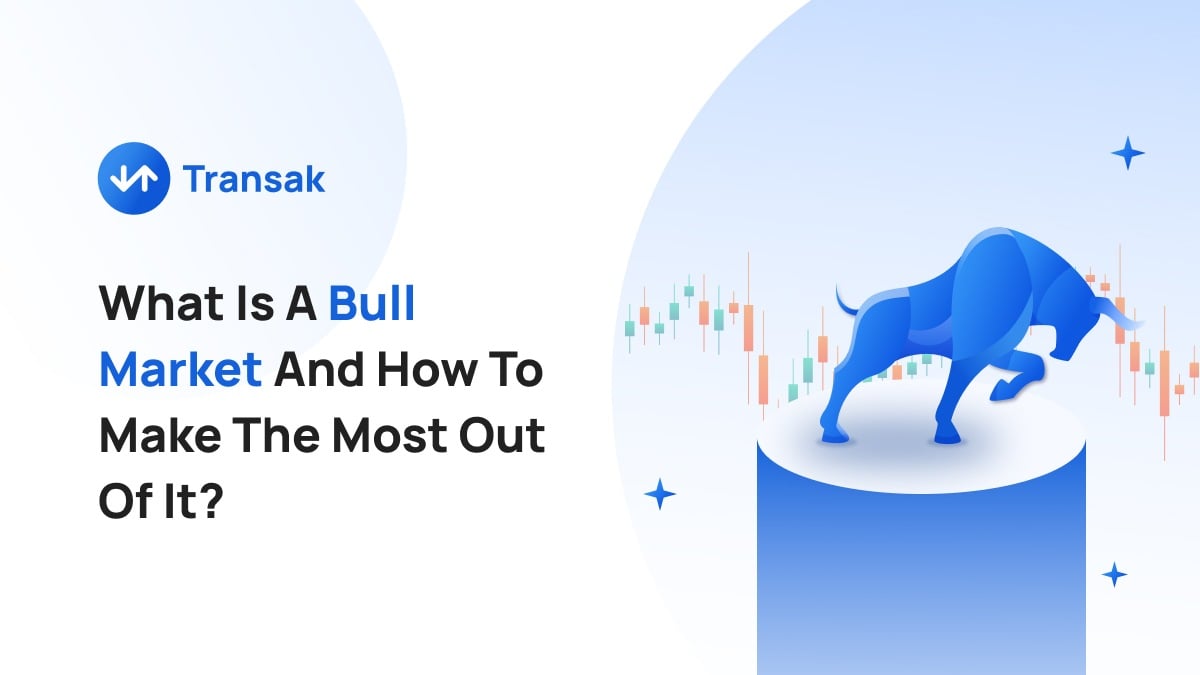The world has varying opinions about the crypto market. But one thing that unifies everyone seems to be its heart-pounding volatility. Here, fortunes can be made or lost overnight!
A bull market presents a golden opportunity for anyone to grow their investments.
So, what is a bull market and how do you navigate the 2024 crypto bull run for maximum gains? With the right insights, signs, and strategies, you can steer your portfolio toward growth.
This article cuts through the noise to pinpoint what drives bull markets, and how to tailor your investment mix for the waves ahead.
What Is A Crypto Bull Market?
A bull market, whether it’s in traditional stocks or cryptocurrencies, is characterized by a sustained uptrend in prices. In the context of cryptocurrencies, this period of rising prices is typically a cycle of three to four years.
Bullish market conditions are often signaled by technical patterns, such as the Bullish Harami pattern, which includes red and green candles indicating potential positive price trends.
Typically, however, economists characterize a bullish market when prices have risen by 20% or more from their recent lows. This percentage increase signifies a significant upward trend in prices, indicating positive investor sentiment and optimism about the market's future direction.
Please note that there isn't a strict numerical threshold for defining a bull market, and different analysts may use varying criteria to assess market conditions.
The presence of these patterns can contribute to the overall bullish market sentiment in bullish markets.
Why “Bull”?
The term "bull" in the context of a bull market comes from the way a bull attacks its prey—by thrusting its horns upward. This imagery is used to symbolize a market where prices are rising or expected to rise.
In a bull market, investors are optimistic about the future prospects of the market, leading to increased buying activity and upward price trends across various securities or asset classes.
Factors Driving Crypto Bull Markets
The driving forces behind a crypto bull market range from market demand and media coverage to government regulations and technological advancements.
The unprecedented demand for Bitcoin, for instance, is fueled by institutional interest, milestones such as the approval of Bitcoin ETFs, and major financial players entering the cryptocurrency market.
Additionally, key on-chain indicators like stablecoin inflows and Total Value Locked (TVL) in DeFi projects indicate a bullish sentiment due to increased liquidity and market engagement.
Bitcoin's Role in Crypto Bull Markets
As the most dominant cryptocurrency with the longest history, Bitcoin functions as a bellwether for the entire crypto sector.
When Bitcoin surges, investor confidence in the broader market bolsters, leading to increased buying activity across various cryptocurrencies. This capital inflow then amplifies gains beyond Bitcoin, often leading to significant growth for altcoins.
Historically, this pattern is evident. The bull markets of 2013 and 2017 were both preceded by a strong upswing in Bitcoin's price. In 2017, for instance, Bitcoin's value skyrocketed, contributing to a massive inflow of capital into the cryptocurrency market as a whole.
This trend is often reflected in a metric called Bitcoin Dominance, which tracks the percentage of the total crypto market capitalization represented by Bitcoin. A rising Bitcoin Dominance often signals an increased appetite for Bitcoin, which can kickstart a broader bull market.
Moreover, Bitcoin serves as the gateway currency for many investors. Newcomers to the crypto space often start by investing in Bitcoin, subsequently using their gains to explore and diversify into altcoins. This rotation of capital amplifies the bull market as altcoins can experience even more meteoric growth compared to Bitcoin.
Institutional interest further solidifies this trend. When institutions invest in crypto, they usually start with Bitcoin due to its established track record and less volatile nature relative to altcoins, driving fresh capital into the market which can further fuel a bull cycle.
Signs of a Crypto Bull Run
Detecting a crypto bull run early can position investors to capitalize on potential gains. Signs of a bull run include a noticeable and sustained increase in the prices of various cryptocurrencies, increased trading volume, and positive sentiment among investors.
During a bull run, altcoins may outperform Bitcoin during certain periods and experience substantial gains.
- Increasing Prices: Consistent and sustained upward movement in the prices of various cryptocurrencies.
- Growing Trading Volume: Higher trading volumes across multiple exchanges indicate increased market activity and interest.
- Rising Market Capitalization: Overall market capitalization of the cryptocurrency market expands as more capital flows into the market.
- Positive Market Sentiment: Bullish sentiment prevails among investors and traders, often reflected in social media discussions, forums, and news outlets.
- New Investors and Users: Increased adoption and onboarding of new users into the crypto space, including retail investors, institutions, and businesses.
- New All-Time Highs (ATH): Cryptocurrencies breaking previous ATHs, especially prominent ones like Bitcoin and Ethereum, can signal a bullish trend.
- FOMO (Fear of Missing Out): Heightened FOMO as investors rush to buy in anticipation of further price increases.
- Media Attention: Mainstream media coverage of cryptocurrencies increases, with positive narratives dominating headlines.
- Development Activity: Increased development activity, new projects, and innovations within the crypto ecosystem, indicating growth and progress.
- Institutional Involvement: Greater participation and investment from institutional players like hedge funds, banks, and corporations.
- Decreasing Volatility: While volatility is inherent in crypto markets, a bull market may see decreasing volatility as prices stabilize at higher levels.
- Bitcoin Dominance Decrease: Bitcoin's dominance in the market may decrease as investors explore other cryptocurrencies, often seeking higher returns.
- Technical Indicators: Bullish signals from technical analysis, such as moving averages, RSI, MACD, etc., indicating buying pressure.
- Halving Events: Positive price momentum can be triggered by events like Bitcoin's halving, which reduces the rate at which new coins are created.
- Regulatory Developments: Favorable regulatory news or clarity can boost investor confidence and drive prices higher.
- Stablecoin Flows: Increased inflows into stablecoins like USDT or USDC might suggest investors are preparing to enter the market or hedge positions.
How To Invest In A Crypto Bull Market
With so many cryptocurrencies available in the market, how can anyone identify the most promising ones?
The short answer is, “Nobody can identify profitable trades with 100% accuracy.” However, we can try and make educated guesses.
This begins by researching deeply about the crypto project, its team, and whether the market is responsive to their offering.
Then, the next steps would include allocating your portfolio based on your due diligence and managing your risk exposure.
Portfolio Allocation
A well-conceived crypto portfolio typically contains 20 to 30 different assets that vary in use cases and risk levels, ensuring diversification and manageability. Regular portfolio rebalancing helps maintain the desired asset allocation, involving the following steps:
- Sell overperforming assets to take profits and reduce exposure.
- Purchase underperforming assets to take advantage of potential future growth.
- Align the portfolio with strategic investment goals and manage risk.
By regularly rebalancing your portfolio, you can optimize your investments and stay on track with your investment strategy.
Risk Management
Risk management is a critical aspect of any investment strategy. Investors should regularly reevaluate their risk profile to prevent their financial well-being from being severely impacted by market corrections.
Continual monitoring and rebalancing of a cryptocurrency portfolio is essential to avoid overexposure and increased risk during market downturns.
Trading Strategies for Maximizing Gains
Understanding and employing effective trading strategies can significantly maximize gains during a bull market. These can range from day trading to trend trading, and each has its advantages and considerations.
Day Trading
Day trading provides opportunities to capitalize on the high volatility and frequent price swings in a bull market. Momentum trading strategies, which utilize technical analysis to identify strong trends for timely entry and exit points, can be particularly effective.
Trend Trading
Trend trading focuses on capturing gains through the analysis of an asset’s momentum in a particular direction. Utilizing indicators like the 200-day moving average can help in determining trend direction and optimal exit points to secure profits.
Dollar-Cost Averaging (DCA)
Dollar-cost averaging (DCA) is a strategy that involves making regular investments of a fixed amount over time, regardless of the asset’s price. This approach can smooth out the volatility in the price of cryptocurrencies and mitigate the effects of market volatility.
Risk during a bull market can be minimized through DCA, by investing in increments and thus reducing the chances of investing a large sum at a price peak.
Narrative-Based Trading
Narrative-based trading in the cryptocurrency market revolves around the idea that market participants often make decisions based on prevailing narratives or stories rather than purely fundamental or technical analysis.
These narratives can be driven by various factors such as technological developments, regulatory news, macroeconomic trends, or even social media hype.
For example, a positive narrative about the potential of blockchain technology to revolutionize industries might drive investors to buy into certain cryptocurrencies even if their current fundamentals don't fully support the hype.
Similarly, negative narratives, such as concerns about regulatory crackdowns or security breaches, can lead to sell-offs and price declines.
Narrative-based trading acknowledges the significant influence of human psychology and sentiment on market dynamics, making it crucial for traders to stay abreast of evolving narratives and sentiment shifts to anticipate price movements in the volatile crypto market.
Narrative-based trading revolves around:
- Identifying and investing in financial assets based on trending stories, popular themes, or prevailing sentiments in the market
- Staying informed about current events
- Monitoring social media trends
- Having a good sense of market psychology
Preparing for Market Corrections
While a bull market offers significant profit potential, it’s equally important to prepare for market corrections.
Having a predetermined exit strategy is crucial to reduce losses or secure profits during these periods.
Setting Exit Strategies
Setting limit or stop orders allows investors to automate the selling process at predetermined prices, helping to either lock in gains or prevent further losses.
Converting altcoin gains into Bitcoin, stablecoins, or fiat is a common way for investors to lock in their profits.
Monitoring Market Indicators
Monitoring key market indicators is crucial for investors to anticipate market corrections and enhance decision-making in the current market, especially in the crypto market.
Signals such as a NUPL ratio reaching around 60% and an MVRV Z-Score about 3 suggest that we may be approaching a cycle high but still have room for an upwards trend.
Conclusion
Maximizing gains in a 2024 crypto bull market involves understanding the dynamics of the market, identifying promising cryptocurrencies, employing effective trading strategies, and preparing for market corrections.
By staying informed and strategic, investors can potentially enjoy significant profits while managing their risk effectively.
Please be informed that nothing in this article constitutes financial advice. We request you to perform your own due diligence or hire a professional for investment advice.
Frequently Asked Questions
Is the crypto market in a bull run?
Yes, the crypto market is currently (at the time of writing) in a bull run, as multiple factors support the bullish momentum and the positive price movement indicates good market depth.
What is a crypto bull market?
A crypto bull market is a cycle lasting around three to four years with a gradual uptrend in prices, often indicated by technical patterns. It signifies a positive price trend.
What are the factors that drive a crypto bull market?
The factors that drive a crypto bull market include market demand, media coverage, government regulations, and technological advancements. These elements collectively contribute to the upward trend in the crypto market.
Why is Bitcoin important in a crypto bull market?
Bitcoin is essential in a crypto bull market as its dominance often signals the start of an upward market trend.
How can investors identify promising cryptocurrencies?
To identify promising cryptocurrencies, investors can conduct fundamental analysis by reviewing a coin's features, blockchain metrics, financial metrics, government policies, and liquidity levels to forecast its growth potential. This helps in making informed investment decisions.
For more information, visit transak.com or follow on twitter.com/transak.






